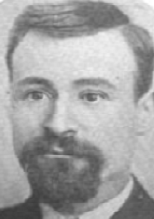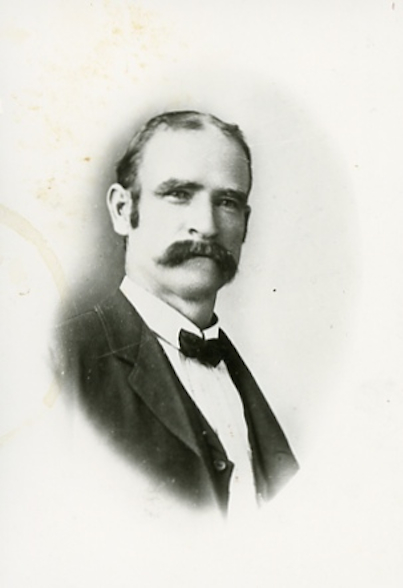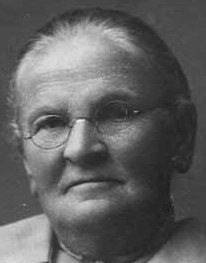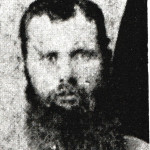Charles Edmund Richardson
(1858-1925)
Charles Edmund Richardson was born in Manti, Sanpete County, Utah, October 13, 1858. He was the son of Mary Ann Darrow and Edmund Richardson, converts to the Church, who had been called to Manti to help increase the population of that city as protection against Walker’s band of Indians. They later moved to Springville, Utah.
From his father, Edmund learned mechanics, carpentering, and building. He was considered a prodigy because of the eas with which he absorbed learning. When he was 14 years old his parents died, leaving to him the care of a younger brother, Sullivan Calvin. This responsibility developed in him resourcefulness and ingenuity. Thoughtful and logical, cheerful but never loud, he was inclined to plainness in clothes and manner, and yet was possessed of natural dignity. He was cautions but never worried or fearful. His hair was red, and, even as an old man, he had an erect figure which he maintained until his death. He had steady blue eyes and grew a heavy moustache. After the death of his parents, he worked fo a short time in the mines but later took his younger brother and went to northern Arizona to join the United Order at Brigham City. There he learned the art of community living and developed his skills in the trades.
Although he had married Sarah Louisa Adams (Sadie) in 1882, and Sarah Rogers in 1887, polygamy was not the reason he moved to Mexico in 1888. Rather, it came about because of a misunderstanding over land. This prompted him to leave Pleasant Valley, near Heber in Arizona, and move south with Sadie and their three small children. He turned to Mexico because his friends and the relatives of his wife were either already there or planning to go there. His recent plural marriage simply supported his decision.
On a hot summer day in 1888, Charles E. Richardson and his family crossed the border into Mexico and settled in Colonia Diaz, a fast-growing Mormon colony three years of age. This was not his first trip to Mexico, for he had interrupted his duties in the Indian Mission in 1885 to be transferred to northern Chihuahua as an interpreter for Apostle George Teasdale and others during the Mexican land purchase negotiations.
Edmund was an immediate asset to the Mexico communities. He set up blacksmith and carpenter shops and came to be rated during those early years as one of the best mechanics among the Mormons in Mexico. He shod horses, made wheelbarrows, and handcarts. He even made a complete windmill, including pump. As a complete wheelwright, he made repairs to wagons and wheels for the colonists. He had taught school on his earlier arrival in Mexico and was one of the first school teachers in the colonies.
During those first years there was much sickness in Colonia Diaz, and no professional medical help was available, only services of several devoted women who served as practical nurses and midwives. Among these were Annie Nelson, Maude Acord, and, later, Leah Jane Keeler, who was a registered nurse. In January, 1891, tow of Edmund’s children died almost the same day. This sorrow so affected him that he resolved to do something about the lack of medical help. He consulted with doctors in Deming, New Mexico, Casas Grandes, and El Paso, Texas. He bought books on medicine and drugs, and charts on anatomy. He purchased a skull and the trunk of a skeleton. With encouragement from area doctors, he began to study medicine earnestly. William Gailbraith owned a large drugstore in Chihuahua City and, when Edmund and his brother, Sullivan, learned that Gailbraith was going to return to the United States, they bought his drug stock.
Aided by regular and frequent consultation with doctors, Edmund became remarkably successful in the practice of medicine among the colonists. In 1892, he was called upon so much for medical service that he was forced to neglect other duties. Often, the gristmill which he had set up earlier was left all day unattended, except by his nine-year-old son Eddie, who was too small to pour grain into the hopper, so the machine ground on without wheat until some older person happened by. This was one of the first water-powered grist mills installed in the colonies. He christened the mill El Molino Joyero, meaning “jewel mill.”
Edmund successfully applied his ingenuity and resourcefulness to many facets of the Mexico colonization project, but perhaps his greatest contribution was with legal problems encountered by the colonists. Many precedents established by cases he fought in the Mexican courts proved invaluable to the welfare of the Saintes long after the Exodus in 1912.
In January, 1896, Edmund received a mission call to Great Britain. This was later changed to Mexico City to allow him to study Mexican law to prepare him to act as legal advisor to the Mormon colony Diaz which, at that time, was considered the most thriving of the colonies. Two other men, Pleasant S. Williams and Hyrum Harris were also called at the same time to study law to prepare for duties at Colonia Dublan and Juarez.
Having lawyers among the Mormons was a wise move inasmuch as the colonists had suffered for lack for legal counsel from the time they first crossed the line into Mexico. Some cases had dragged on for years and amounted to nothing less than extortion or blackmail. In compliance with the missionary call, Edmund enrolled as a student at the University of Mexico where he completed a four-year course in two years and graduated with honors.
Through a series of circumstances, Edmund became the only “home grown” lawyer in the colonies and the sole source of legal counsel unless Mexican lawyers were engaged, whose sympathies were not always clear. A fellow colonist said of him, “As a lawyer in Mexico, Edmund Richardson knew his stuff.” And a Mexican lawyer is said to have observed, “If Don Edmundo is on the other side, we will not take the case.” He had a phenomenal memory and the word of Don Edmundo, as he was called, came to be received with deference at the jefetura (county seat). His son Edmund is authority for the statement that Charles Edmund Richardson never lost a case in the Mexican courts.
In 1889 Richardson married Caroline Rebecca Jacobsen, and, in 1904, Daisy Stout. He had also brought his second wife, Sarah Rogers, down to Mexico. Edmund was a family man cum laude. His family and genealogical records kept in his own handwriting are examples of his efficiency and thoroughness and compliment to his love for his families. That the family was due to their deep religious convictions, forbearance, and the wise counsel and just dealings of of the husband and father. He created such harmony and good attitudes that the family continued to have close and strong bonds of affection even after Edmund had died.
In the latter part of 1904, Edmund moved his wife Sadie to Colonia Juarez and later established a home there for his fourth wife Daisy. This move provided a home for the lawyer during the time his legal duties kept him a t Casas Grandes, county seat, and put the children near the Juarez Academy. However, Sadie and Daisy often returned to the ranch at Colonia Diaz to spend the summer.
An incident told by Edmund’s daughter, Hazel, reveals the need of the people for the help he could and did give. “One day,” said Hazel, “not long after my father’s death, I met Daniel Skousen of Colonia Juarez on the streets of El Paso, Texas. AS soon as the greetings were over, he asked me where my father could be reached, and said, “We need him so much. If we could only persuade him him to come back to the Colonies! The people down there are in trouble and he is our only hope. He must come back!” When I finally said, “He is dead,” Uncle Dan Remarked, “No one will ever do for the colonies what he has done. He filled his mission faithfully and well. He knew how to handle the Mexicans and they knew that they would receive justice.”
Adam Fredrickson of Colonia Diaz noted that:
Edmund Richardson was a student of merit, utilized all his spare time for study. His overland trips were made with a team and a book. He spoke both Spanish and English fluently. His interesting and enlightening sermons were second to none, and were enunciated clearly. He had the best control of his temper of anyone I knew. Once while he was fencing his property, an angry stockman who favored open grazing reviled him with abusive language and every foul name at his command. Richardson went calmly about his work remarking, “If you get any pleasure out of calling me such names, just go ahead.” Even when the cattleman threatened to strike with a shovel, Richardson laughed him out of it. He was a friend to everyone… He helped many a poor family enjoy a better Christmas because he helped Santa put dolls and toys on the community Christmas tree.
Edmund Richardson tried to make the best possible use of every hour for he believed that wasting time was foolish and irresponsible. He read avidly while traveling to his appointments at the courts, or on business, thus accumulating a superior store of knowledge.
Because he was so capable, it was sometimes a relief to find that he was human, too. An incident will illustrate this. His wives, Sadie and Becky, when they fed the pigs, were in the habit of going together, one carrying the feed in a bucket and the other armed with a large stick to keep off the pigs as the women approached the trough. One day Edmund was at home, he decided to feed the pigs himself. “Take a stick,” cautioned Sadie. “Never mind my dears. Don’t worry. I will take care of myself,” he called back as he walked away out the kitchen door, both knowing well the difficulties involved, and yet wondering if he could possibly take care of the situation. But before he reached the trough, an overeager pig had run from behind, pushed himself between Edmund’s legs, tripping him. Before he realized what was happening, Edmund was down on the ground, completely out of sight of the watching women, surrounded by a horde of scrambling, pushing pigs. It is understandable that the story was told and retold with relish by the wives. The husband, after all, was just human enough to still have something to learn.
Charles Edmund Richardson’s versatility was evident by his many activities: law, medicine, cattle raising, farming, mechanics and blacksmithing, teaching, designing and building, reconciliation fo the needs and demands of his wives and pluaral families, not to mention his church activities. He managed to crowd all these activities into his life with a fair degree of success in every area. He seemed to have a driving force and ability to manage his time which enabled him to accomplish what he did.
His daughter, Hazel R. Taylor, happened to be talking with Anthony W. Ivins, President of the Juarez Stake in Mexico, and perhaps Edmund’s closest friend in Mexico. At the time of the conversation with President Ivins was then in Salt Lake City as Counselor to the President of the Church. President Ivins said, “Do you know you have a wonderful father?” Hazel, who adored her father, as did all his children, said, “Well, I am his child and perhaps inclined to be prejudiced, but I think that my father is just wonderful!”
Brother Ivins went on, “I suppose that he did as much or more good for the colonies in Mexico that any other man. Did you know that except for one thing he would have had many important positions in the church, but we couldn’t depend on him…” Shocked, Hazel interrupted him to expostulate regarding her father’s dependability. She said she could not imagine him, who knew her father so well, thinking such a thing. President Ivins quickly said, “Now wait, let me explain,” and went on to say that her father had a brilliant mind, that his capabilities were remarkable, that his spirituality was far above average, and that his principles were unquestioned, but that because of his mission he could not be relied upon to fill scheduled church appointments.
This was certainly true. When he was teaching commercial law at the Juarez Stake Academy, the only way students knew whether he was in town was by the ringing of the bell. Edmund would advise the custodian, John Allen, when he came into town to ring the bell and students would prepare for class. Because his lessons were so enjoyable he was retained as the teacher of the adult class in Sunday School for many years. Likely as not, Brother Richardson would be found in some Ward other than his own on a Sunday, and was usually called upon to talk in his clear yet deep and thoughtful way to an appreciative audience while his Sunday School class accepted a substitute.
So it was true, as President Ivins indicated, the positions Edmund held in the Church did not reflect the extent of his abilities, his spirituality, or his dependability. Through he valued his property holdings, he valued his membership in the Church and his testimony of its truthfulness far more. His entire life dedicated to compliance with its demands. He honored his priesthood and was sincere in his devotion to it. He vowed to submit to authority, and succeeded in every instance. Great characters stand tall, and Charles Edmund Richardson towered with other stalwarts who established and maintained the Mormon colonies of Mexico. He was a pillar of strength on whom others depended for help.
In August, 1925, Edmund became ill and passed away. H was buried in Thatcher, Arizona. He was the father of 36 children, 24 of whom grew to adulthood. If there is anything that can be said to describe the family generally, it would be an unusual closeness among the families of the four wives, the clean living and high moral character of the family members, and their involvement in church activity. Among his posterity are found professional men and women in the fields of medicine, education, law, and finance.
Compiled and submitted by members and descendants of the Charles Edmund Richardson family
Stalwarts South of the Border Nelle Spilsbury Hatch, page 564





